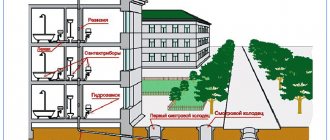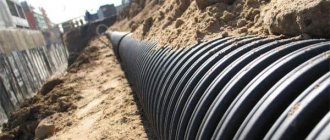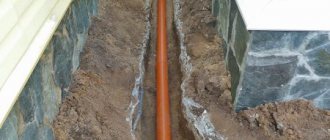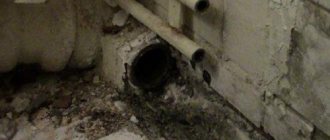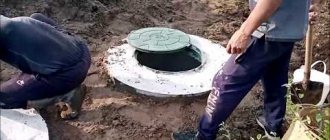Plugs for internal sewerage
With the advent of plastic sewer pipes, which replaced cast iron ones, all types of work on their installation and maintenance have become significantly simplified. Standardized sizes of pipes and piece connecting elements make it easy to select plugs and other auxiliary devices for them.
Internal sewerage wiring throughout the house is made of gray pipes. All additional elements have the same color: couplings, tees, bends, adapters to another diameter and other parts with which the system is articulated. The sewer pipe plug is no exception.
It is a plug in the shape of a cylinder, open on one side and plugged on the other with a round plate of larger diameter, the edges of which extend beyond the walls of the cylinder by several millimeters.
Plug for pipe 110 mm Source vostroy.kiev.ua
See also: Catalog of companies that specialize in water supply, sewerage and related work
Pipes for internal sewerage have a diameter from 32 to 110 mm. They differ from the external ones not only in color, but also in the small thickness of the walls, amounting to only 1.5-2 mm. This is quite enough to withstand the small loads that arise in an openly laid intra-house system.
The pipes are connected to each other and to additional elements using sockets, the length of which depends on the cross-section of the product.
- With a diameter of 32 mm and 40 mm, the length of the bell is 31 mm.
- With a diameter of 50 mm – 37 mm.
- The socket length for 110 mm pipes is 49 mm.
The sewer plug is made taking into account these dimensions, since it is inserted into the socket and fixed in it with a rubber sealing ring located in a special groove. The inner diameter of this ring tightly wraps around the cylindrical leg of the plug, creating a reliable barrier to the escape of liquids and gases. The plug holds well the pressure that arises in the pipes, which is not high in gravity systems.
Socket with rubber gasket Source stroimaterial-moskva.ru
Installation technology
Methods for installing plugs depend on what type was chosen. The most common are in the form of lids with a rubberized ring. Installing them does not require special skills. To do this, just select a plug of a suitable diameter. The material from which it is made must match the material of the pipe.
A rubberized ring is placed between the pipe and the plug, with an additional layer of sealant applied to it. This will increase the tightness of such a connection. Then put on the plug before the sealant hardens, pressing it tightly against the pipe. This completes the installation process.
It is important! When installing a regular plug, there is no need to worry about its tightness. The sewerage system is a non-pressure system. The pressure inside it is small, so the plug will not move during operation or leak liquid. The main advantage of such a plug is the speed of installation and dismantling.
Threaded plugs are screwed into pipes using threads. They can often be found on metal pipes. For sewerage, this type of connection is rarely used, despite the fact that it has greater tightness than a conventional plug without a thread.
We recommend that you read: Correct installation of a sandwich chimney with your own hands - assembly diagram
Gate valves with flange connections are secured using special bolts. They are installed on large highways, where there is a need for these types of plugs.
Welded ones have the best tightness. To install them, you need a special pipe welding machine. The end of the pipe and the plug are inserted into the jaws of such a device, welding these parts to each other. This is a permanent type of plug, which is also non-removable. It is not often used for sewer systems.
Pneumatic plugs are used by utilities. These are parts that are made of dense rubber and inflated to increase in volume. In the deflated state, the plug is inserted into the pipe and advanced to the outlet of the final consumer of the service. It is inflated in the right place and it closes the lumen, tightly touching the walls of the pipe.
Plugs for external sewerage
The color of external sewer pipes and all additional elements for them is orange. And the wall thickness of all products, including plugs for sewer pipes, is 3.2 mm or more, up to 6 mm. This significant difference is explained by the fact that external lines must withstand soil pressure and operate in a wide temperature range.
Since pipes with a diameter of 110 mm and above are used for external systems, plugs for them are produced with the appropriate cross-section. They have the same shape as the internal ones and are produced by soldering a cylindrical leg with a lid or molding a single structure under pressure.
Installing sewer plugs is quick and easy, regardless of their diameter and purpose. To ensure that the plug fits gently into the ring and does not damage it, the stem of the plug can be moistened with soapy water.
How to remove
Shutting off the sewer system is rarely required, but situations may arise in which it is necessary to remove the plug to ensure the sewer system is connected to the house or apartment. It is important to understand this procedure to ensure perfect results. If there is no opportunity or desire to deal with the process yourself, then you can contact various specialized services.
How to remove a plug from a sewer? This process depends on which element you are dealing with:
- if a rubber plug is installed, it is simply pierced, for which any cutting tool is used. The element has thin and soft walls, so there are no problems with its deformation. To do this, a metal and sharp tool is lowered into the pipe using a plumbing cable. After cutting the rubber plug, it deflates and simply falls out of the system;
- if there is a product made of plastic or metal, then it is quite easy to move it in any direction, and this process is carried out either manually or using standard pliers. It is advisable to pull it out so that it does not remain in the system. To do this, just tighten the stop of the plug. If it is not possible to pull it out of the pipe, then it must be fixed with a spacer so that it is not washed away by wastewater;
- It is often impossible to move hard metal or plastic plugs. In this case, a hole is formed in the riser, and in such a way that it is at a convenient angle to the plug. A metal pin is inserted into the resulting hole until it hits the product. You need to hit it with a hammer to move the plug;
- in a plastic element it is enough to simply make a hole with a sharp knife, and a core drill is often used for these purposes. It is not recommended to use this method for metal products because they are springy. Therefore, it is most optimal for them to use an angle grinder. The cut elements are simply pulled out of the system;
- if there is a lattice structure, then you just need to saw or cut through the existing rods.
If the work must be performed by the owner of an apartment located on the top floor of an apartment building, then access to the pipes is easy to obtain through the roof or attic of the building.
When working with cast iron pipes, it is important to be careful not to damage the sewer.
Removing the plug should be entrusted to professionals.
You can remove the plug from the sewer yourself even using chemical methods. For this purpose, special products containing oxalic or hydrochloric acid are used. However, in reality, this method is characterized by low efficiency and effectiveness. Also, when using aggressive chemicals, there is a high probability of causing irreparable damage to the pipes themselves. The products begin to work after several days of use, so the process is delayed for a long time. If you perform the process carefully and efficiently, you can use the plug again for another section of the sewer system.
Thus, sewer plugs are effective and efficient tools that allow you to block the sewer riser if necessary. They are represented by several types, differing in installation principles, service life and production material. Their installation is a rather complex and specific job that requires specialized equipment. If you need to remove an element, then it is important to figure out which method for these purposes will be the most optimal and effective, and its choice depends on the type and installation features of each structure. If you take the work responsibly and seriously, then there is a high probability of receiving a high-quality element that can be reused after dismantling.
Briefly about the main thing
Among the individual additional elements produced for the installation of sewer systems, there are not only parts for their articulation, but also plastic plugs for sewer pipes. They are designed to temporarily block pipes and outlets into which debris may fall during construction work or small animals may enter. Another purpose of plugs is to seal holes from which sewage and harmful gases can enter the house. They can be easily removed if you need to connect a plumbing fixture to the outlet or clear a blockage from the pipe.
Ratings 0
Is it possible to remove the plug yourself?
Removing the plug takes from several minutes to several hours, depending on the type of part and the method of its fastening. The plugs that are installed externally can be removed independently.
It is not recommended to dismantle internal limiters installed by utility services without specialists.
The simpler the installation, the easier it is to remove it later. It is not recommended to apply additional products, including sealants, to plugs that will be frequently removed, for example, for inspection.
A plug that is welded to a pipe can only be removed by cutting off the corresponding part of the pipe; these are disposable.
Can utility workers turn off the sewer system?
Many citizens are interested in whether sewerage can be blocked for debts. The thing is that in the current version the direct ban on turning off the sewer system has been abolished. In this regard, management companies (MCs) that collect payments are now threatening defaulters with suspension of the resource supply.
It states that the only way to influence malicious debtors and non-payers of housing and communal services is to limit or suspend water drainage and water supply.
At the same time, in search of an answer to the question of whether housing and communal services can turn off sewerage, it is worth considering that the above-mentioned resolution contains an important condition, according to which the suspension of any type of utility services should not:
- damage the common property of residents of an apartment building;
- violate the rights of other owners, including the suitability of residential premises.
Therefore, if a consumer doubts whether the sewerage system in the house was legally turned off, you can go to court to stop interfering with the sanitary and technical condition of the apartment building equipment.
Parts used by utilities
As practice shows, one of the most effective means of dealing with citizens who do not want to pay for utilities is to install plugs in the sewerage system. The advantage of this solution:
- You can block access to the sewerage system within a few minutes, and there is no need to enter the apartment of a person who has a debt;
- the installation of such a plug does not in any way prejudice the residents of apartments located along the riser;
- When using this measure, the likelihood of damage to the riser or other plumbing equipment is zero.
How it works? Very simple:
- installation is carried out in the attic or on the roof, the craftsmen do not need to ask the debtor to let them into the apartment;
- the device is lowered down the riser on a cable to the required floor (monitoring is carried out using a video camera);
- the plug is inserted into the outlet hole and inflated with air;
- After installing the plug in the apartment, it becomes impossible to drain water.
Advice! There is no need to go as far as installing a plug. Even if the family is in financial difficulties, you should contact the management company and draw up an agreement on debt restructuring.
Can I remove the plug myself?
Of course, the easiest and safest way to get rid of the plug installed by utilities that blocks the exit to the riser is to pay off the existing debt. In this case, the specialist will remove the installed plug in just a few minutes. But some residents try to remove the obstacle themselves. “Craftsmen” advise using two methods:
- chemical;
- mechanical.
I would like to warn you that the riser blocking the lumen is made of the same material as the pipe itself. So, if you try to dissolve it by introducing caustic substances into the sewer, it can lead to the destruction of the pipes. And subsequent repairs may require investments that will exceed the amount of debt.
The second method of removal is mechanical. You can try to push the plug further along the riser using a plunger or a plumbing cable. But this method also has disadvantages. After such an operation, the likelihood of blockage in the public sewer system increases. Of course, this will not be a problem for a single apartment, but for the entire house, but it is unlikely that the neighbors will be delighted when the cause of the blockage is found out.
So, plugs for sewer pipes are installed for different purposes. But the function of this part is the same in all cases; it blocks the movement of fluid flow. It is quite possible to install a plug on a pipe or an open branch of the riser yourself; it is a fairly simple job.
Purpose of a plug for a sewer pipe
Sewer blocking for debtors
Plugs are made of metal, plastic and rubber. Polypropylene products, PVC and cast iron models are very popular. Many blocking devices have a smooth surface, which prevents the accumulation of fatty deposits on the side of the riser.
Installation of a valve or other stopping device is carried out unscheduled or in advance. The procedure is aimed at achieving the following goals:
- completely block part of the riser for its repair or partial replacement;
- close the lumen of the channel to drain and clean the clogged area;
- connect drain hoses of sinks and household appliances;
- inspect and service the joints of pipes of different diameters;
- block drains during scheduled repairs of the riser at the entrance to the apartment wiring.
The legality of installing a plug is confirmed by Art. 21 Federal Law No. 416 dated December 7, 2011
Alternative option
If the toilet is securely fixed to the floor or removing the plug from the sewer is impossible, but there is an inspection hatch, it makes sense to work through it. In this case, you need to be careful, because waste or hot water may pour from above; do not neglect protection. It's simple:
First, the inspection window or hatch opens. You need to have a harpoon or a long stick with a hook, which will need to be used to pick up the plug. There is a possibility that the tool will slip out of your hands and fall down, making it impossible to get it out.
Therefore, it is worth tying a rope to the end and leaving it outside so that you can intercept it if something happens. Carefully pry the plug and remove it. You need to act very carefully so that it does not fall and block the riser.
After completion of the work, the hatch must be closed and the plumbing installed in place.
Purpose of the device
The plug is a kind of valve that closes the sewer hole intended to connect the common riser with the system of a separate apartment. This method is used by utility service employees when non-payers do not allow them into the apartment.
The partition is installed on a branch from the common riser.
The device is inserted through a drain pipe that goes into the attic, and a valve is installed. It prevents waste from passing through the drain. Accumulating near the plug, they clog the toilet and pipes that extend from the bathtub and sink.
The rate of clogging is determined by the type of valve. If it is made in the form of a lattice, then water will pass through, and only solid particles will accumulate. When installing a solid plug, the side hole is completely blocked.
This is interesting: Step-by-step instructions for repairing a ball valve: it’s better to see once
The occurrence of blockages
List of reasons
- Wear and tear of sewer pipes (poor flow capacity)
- Ingress of large debris
- Residents doing renovations flush waste construction materials down the toilet.
What to do?
When there is a blockage in the sewer riser, the reason is no longer important. Apartments on the first two floors suffer. The sewer column rarely rises higher.
The speed at which our emergency services work is needless to say. By the time they get there, they will identify and eliminate the cause. The entire home may be filled with sewage. To put it mildly, this will cause discomfort.
Installation features
When the employees of the service organization have taken all measures to eliminate the debt for utilities (sending appropriate notifications), a sewer plug can be installed for the defaulter. It is installed in such a way as not to cause discomfort to other residents of the apartment building.
To install the blocking element correctly you need:
- manipulator;
- remote controlled video camera;
- fiber optic wire providing illumination of the structure.
The plug in the sewer is installed in the following sequence:
- Study the structure of the drainage system, understand what material it is made of, check for the presence of additional drainage from the defaulter’s apartment.
- Determine the installation location of the blocking device. It is installed using an internal pipe leading from the toilet to the common riser.
- Find the entry point from which the equipment will be launched into the system. For this purpose, a vent pipe located on the roof is used.
- Insert the manipulator into the water channel and gradually lower it down. The camera fixed on it allows you to find the installation location.
- When the installation point of the blocking element is reached, lower the plug and insert it from the side of the apartment sewer.
- Secure the plug.
To install a drain blocker, it is necessary to undergo training, so this work is performed only by employees of the housing and communal services or service company.
Tips for choosing
Professionals recommend taking a responsible approach to choosing methods and means for blocking sewer pipes.
You should pay attention to the following aspects:
- strength;
- durability;
- tightness;
- material compatibility;
- maintainability.
Calculations must be made for extreme operating conditions.
Thus, clearing blockages can be carried out using household chemicals, a cable with a sharp tip and a jet of water under high pressure.
Conclusion
We have discussed pipe plugs in some detail. We looked at what they are, what to look for when purchasing and installing such products. In addition, they also touched upon how the sewer plug is dismantled for non-payers.
I would like to believe that all this information will be useful to you. And if there seems to be little information, then we advise you to watch the additional video in this article.
Did you like the article? Subscribe to our Yandex.Zen channel
Legality of sewer blocking
When determining the competence of the actions of public utilities, one should proceed from the fact that blocking the sewerage system for debtors is not associated with violations of the rights of residents to the apartment. It remains suitable for living, but without proper comfort, coziness and amenities. Moreover, government regulations prohibit restrictions on cold water supply and heating services.
Decree of the Government of the Russian Federation No. 307 of 2006 “On the provision of utility services to citizens” provides for the possibility of disconnecting hot water, sewerage and electricity supply for non-payment.
The limitation of water disposal complies with the current regulatory legal acts of the republic. Regulators must inform debtors in advance about the proposed measures. Only in this case the legality of their actions will be respected.
Source
Types and differences
There are many types of shut-off elements designed for installation in plastic, steel and cast iron water pipes. Plugs are made from the materials from which the pipes are made.
The exception is cast iron pipes, onto which plastic fittings with bends are attached for connecting shut-off devices.
Permanent
In most cases, permanent plugs are installed during the pipeline installation process during the construction phase of the building. They cut into the highway at the points of branches, turns and its exit into the general system. When transferring premises from the residential to service category, the sewerage system is dismantled and the remaining pipe is plugged.
The constipation is fixed to the pipe using welding, glue and an external threaded connection.
Temporary
Products of this type are used for short-term blockage of reserve, emergency and mothballed sections of pipelines. They are secured so that at any time the locking device can be removed and the section of the main line can be put into operation. As a rule, the pipes are plugged with plastic plugs with rubber seals, due to which complete sealing of the connection is achieved.
If there is a risk of the plug breaking, then a decision is made to install an external cap with an internal thread.
Inflatable
Pneumatic locks are used in cases where it is necessary to disconnect a separate apartment from a common riser. For this purpose, a special technology is used, which involves the presence of a video surveillance system, a remote manipulator and a compressor.
The inflatable device is immersed in the riser and lowered by cable to the desired level. After this, under the control of a video camera, the manipulator places the tank in the side pipe. Using a vacuum valve, the operator inflates the ball and disconnects the cable.
Mechanical
There are several types of mechanical sewer locks. They are used to achieve a specific goal.
Thus, metal mesh is installed to block feces in the apartments of debtors. Such devices provide liquid drainage.
Petal devices are embedded into the system itself or installed inside the pipe. The valve moves to a predetermined location, after which the blocker is turned on, which firmly secures the product inside the main line.
